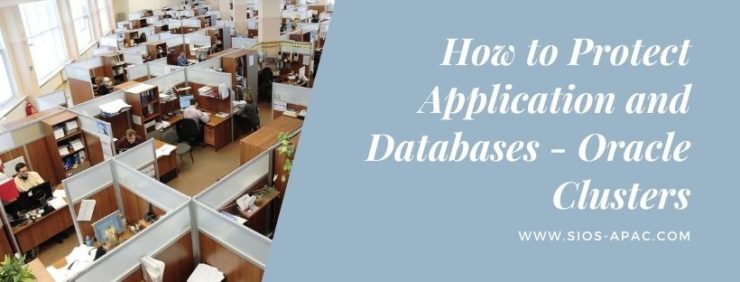Date: January 25, 2022
Tags: Oracle Clustering
How to Protect Application and Databases – Oracle Clustering
Oracle Clustering Without RAC: What You Need to Know
What is an Oracle Cluster?
A failover cluster is a way of providing high availability protection for applications by eliminating single points of failure by running the same operating system and databases and applications on multiple servers all of which share the same storage or connect to storage that is continuously synchronized. Oracle runs on one of these servers, called the primary. If it fails, application orchestration software (clustering software) moves operations over to one or more secondary servers in a process called a failover. Since the primary and remote servers access the same or identical storage, the Oracle operation can continue with minimal recovery time or data loss. Many organizations consider Oracle to be the backbone of their operations, especially if they are using an Oracle-based SAP system or Oracle ERP System.
What is Oracle RAC?
Oracle’s clustering software is called Oracle Real Application Clusters (RAC). RAC “enables you to combine smaller commodity servers into a cluster to create scalable environments that support mission-critical business applications.” [1] With Oracle RAC, you can cluster Oracle databases and use Oracle Clusterware to connect multiple servers, so they operate as a single system.
While RAC was previously bundled with Oracle Database Standard Edition (at no extra charge), Oracle has now removed the RAC feature from Standard Edition from version 19c onward. You can purchase Oracle RAC for an additional cost with Oracle Database Enterprise Edition. Unfortunately, this means that any customer wanting to use RAC must upgrade to Oracle Database Enterprise or migrate to the Oracle cloud, both of which are substantially more expensive solutions than the Standard Edition.
SIOS provides a high availability Oracle clustering solution without upgrading to the Enterprise Edition, saving up to 70 percent on licensing costs.
SIOS Protection Suite for Linux (Oracle Linux, Red Hat, SUSE)
The SIOS Protection Suite for Linux provides a tightly integrated combination of high availability failover clustering, continuous application monitoring, data replication, and configurable recovery policies, protecting your Oracle database and applications from downtime and disasters. Unlike other clustering solutions that only monitor the server’s operation, SIOS LifeKeeper monitors the health of servers, network connections, storage, all Oracle processes, and any associated applications. Problems are immediately corrected via a set of policy-defined actions ensuring fast recovery without disruption to end-users.
SIOS Protection Suite can operate in a shared storage (SAN) environment to support a traditional HA cluster, or in a shared-nothing (SANless) storage configuration in cloud, hybrid, and other environments where shared storage is impractical or impossible. It delivers a robust, versatile, and easily configurable cluster with automatic and manual failover/failback recovery policies for your Oracle databases and applications.
SIOS Protection Suite for Linux includes:
- SIOS LifeKeeper, which provides flexible failover clustering software that monitors the entire application stack
- SIOS DataKeeper, which provides fast, efficient host-based, block-level data replication for mirroring local storage in a SANless cluster configuration or replicating to remote locations or cloud for disaster recovery
- Multiple Application Recovery Kits (ARKs), with automated configuration and validation tools built into the product to protect your business-critical applications and data from downtime and disasters.
SIOS LifeKeeper supports all major Linux distributions, including Red Hat Enterprise Linux, SUSE Linux Enterprise Server, CentOS, and Oracle Linux and accommodates a wide range of storage architectures. SIOS software has been adapted and optimized to run on these operating systems and the components are tested to ensure the SANless cluster solution will work on each OS.
SIOS Supports Oracle Clustering in the Cloud
With the SIOS Protection Suite for Linux, you can run your Oracle applications in a flexible, scalable public cloud environment, such as Amazon Web Services (AWS) or Microsoft Azure, without vendor lock-in or sacrificing performance, high availability, or disaster protection.
SIOS Protection Suite for Linux on AWS or Azure provides the elements you need to create a high availability Linux cluster across cloud Fault Domains and Availability Zones giving you geographical separation for protection from sitewide and regional disasters and outages.
In a Windows Server Failover Clustering (WSFC) environment, you can use SIOS DataKeeper Cluster Edition to synchronize local storage using efficient host-based replication for SANless clustering. SIOS DataKeeper Cluster Edition software protects your business-critical Windows environments, including Oracle, from downtime and data loss.
SIOS Supports Oracle Clustering in Virtual Environments
SIOS SANless cluster software provides the enterprise-grade high availability, reliability, and flexibility needed for your Oracle databases and applications when operating in VMware, Hyper-V, KVM, and XenServer environments.
SIOS Protection Suite for Linux protects your Oracle databases and applications running on Linux in a virtual environment. If you are running Oracle on Windows in a virtual environment, SIOS DataKeeper Cluster Edition protects your business-critical Windows environments, including your Oracle databases and applications.
SIOS offers integrated data replication, high availability clustering and disaster recovery solutions supporting Oracle on both Linux and Windows to provide fault-resilient protection for small and large organizations alike at a fraction of the cost of other Oracle clustering solutions. With SIOS SANless clusters, you do not need expensive shared storage to achieve full high availability application and database protection. Instead, you can run your Oracle databases and applications in the cloud where there is no SAN. And, SIOS can protect your Oracle database and applications on-premises and in virtual and hybrid environments as well.
For more information on how SIOS can protect your Oracle databases and applications, click here or a personalized demo.
[1] https://docs.oracle.com/cd/B28359_01/rac.111/b28254/admcon.htm#RACAD7148
Reproduced with permission from SIOS
